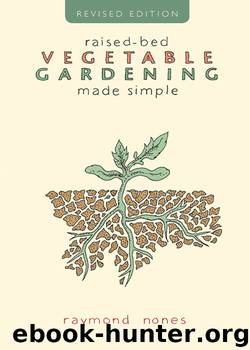Raised-Bed Vegetable Gardening Made Simple by Raymond Nones

Author:Raymond Nones [NONES, RAYMOND]
Language: eng
Format: epub
ISBN: 978-1-58157-710-5
Publisher: Countryman Press
Published: 2013-11-11T05:00:00+00:00
Note: Furring strips have been specified because they are cheap. Regular 1x2 lumber will cost more but give you a better job and is recommended.
Once the training method is known, the tomato transplants can be set into their designated planting units.
But first, since tomatoes follow peas as a succession planting, the pea vines standing in those units will have to be removed. They will have served their purpose as a cover crop, having added nitrogen to the soil. Sadly, the not yet fully mature pods on those vines will be lost. I know, it will tug at your heart, but just grit your teeth, pull them out, and add them to the compost pile.
A pea harvest will still be had as the rest of the crop, that in-between those planting units, will remain and be harvested.
Setting out the transplants
The organic gardener’s basic rule of thumb is: Feed the soil and allow the soil to feed the plant.
Organic matter in the soil improves the texture, increases workability, intensifies water holding capacity and slowly releases nutrients for use by the plants. It is vital for the health of your plants to always have plenty of it in the bed.
A few days before setting out the plants rake the bed smooth and spread a half-inch layer of compost over the entire area. This will provide extra nutrients to get them off to a good start.
For strong normal growth, if some plants have developed blossoms, remove them before setting in. This may seem contrary to logic, but if left on energy will be diverted to developing fruit instead of to the development of a sturdy root system. Once a plant begins to flower and set fruits it is entering its most vigorous vegetative growth. This stage should always be after the plant has been set into the garden and has strong roots.
In the early morning of the transplanting day water all of the plants to keep them fresh, but since bright sunlight can harm the tender young seedlings, do not set them out until late afternoon when the sun has started to decline and has lost most of its heat.
This also gives the young plants all night to start adapting to their new environment before getting hit with the hot sun the next day. Try to keep the roots in your shadow when out of their containers.
Plant in two clusters of six: Each cluster in its designated planting unit, two single rows to a cluster, rows 14 inches apart, plants spaced 14 inches apart in the rows. Measure and mark the positions where the plants are to go.
To remove transplants from their containers hold them so that the stem is in-between your forefinger and middle finger, turn them upside down and give a sharp tap on the bottom. Usually they will come out easily. If they don’t, run a knife all around the inside edge of the container and try again.
After removing from container, inspect the root ball. If roots are matted or circling around the root ball untangle them and spread them in an outward direction.
Download
This site does not store any files on its server. We only index and link to content provided by other sites. Please contact the content providers to delete copyright contents if any and email us, we'll remove relevant links or contents immediately.
Turbulence by E. J. Noyes(7717)
The Thirst by Nesbo Jo(6450)
Gerald's Game by Stephen King(4385)
Be in a Treehouse by Pete Nelson(3654)
Marijuana Grower's Handbook by Ed Rosenthal(3520)
The Sprouting Book by Ann Wigmore(3422)
The Red Files by Lee Winter(3285)
The Remains of the Day by Kazuo Ishiguro(3148)
Sharp Objects: A Novel by Gillian Flynn(2852)
Christian (The Protectors Book 1) by L. Ann Marie(2607)
Organic Mushroom Farming and Mycoremediation by Tradd Cotter(2572)
The Culinary Herbal by Susan Belsinger(2342)
Stone Building by Kevin Gardner(2297)
Lilac Girls by Martha Hall Kelly(2205)
The Starter Garden Handbook by Alice Mary Alvrez(2203)
The Unlikely Pilgrimage of Harold Fry by Rachel Joyce(2140)
The Lean Farm Guide to Growing Vegetables: More In-Depth Lean Techniques for Efficient Organic Production by Ben Hartman(2014)
Urban Farming by Thomas Fox(1987)
Backyard Woodland by Josh VanBrakle(1835)
